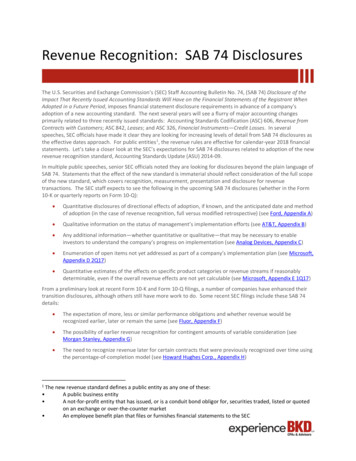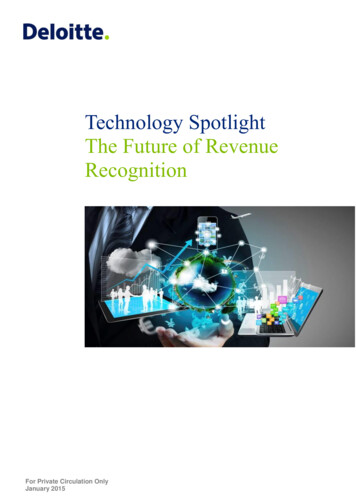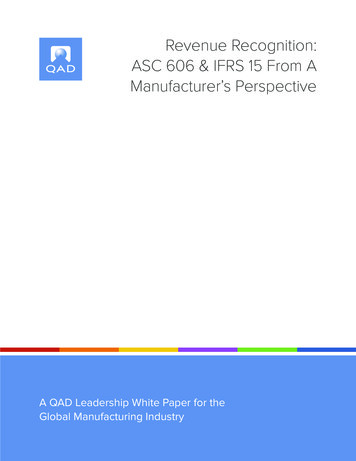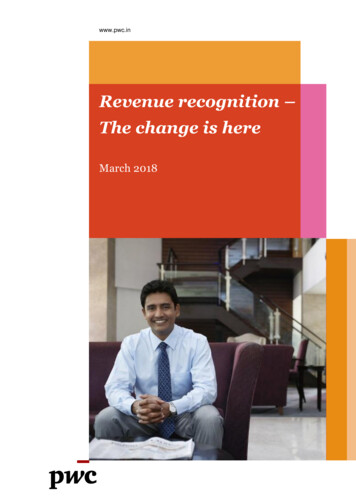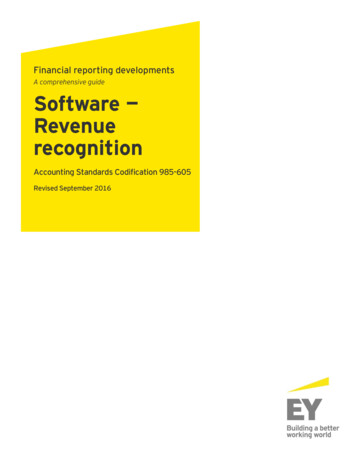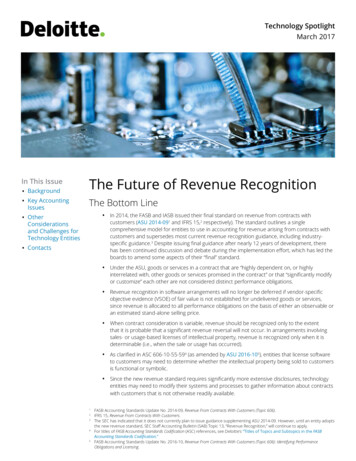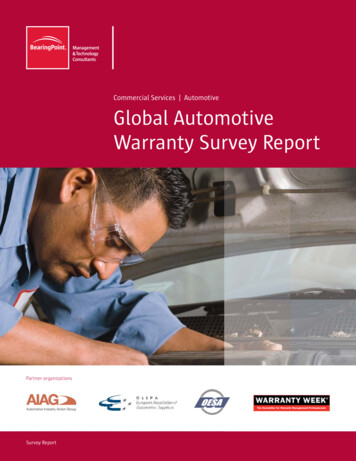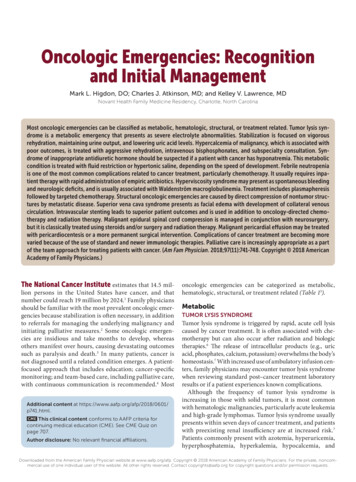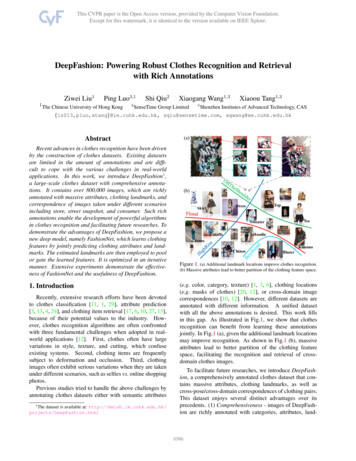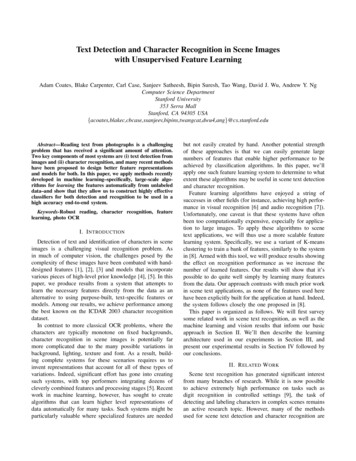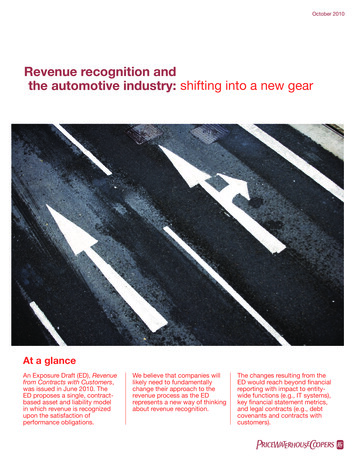
Transcription
October 2010Revenue recognition andthe automotive industry: shifting into a new gearAt a glanceAn Exposure Draft (ED), Revenuefrom Contracts with Customers,was issued in June 2010. TheED proposes a single, contractbased asset and liability modelin which revenue is recognizedupon the satisfaction ofperformance obligations.We believe that companies willlikely need to fundamentallychange their approach to therevenue process as the EDrepresents a new way of thinkingabout revenue recognition.The changes resulting from theED would reach beyond financialreporting with impact to entitywide functions (e.g., IT systems),key financial statement metrics,and legal contracts (e.g., debtcovenants and contracts withcustomers).pwc
Revenue recognition and the automotive industry“The revenue recognition exposure draft is not justa facelift of the same old standards; the FASB andIASB have unveiled a redesign of the guidancethat will likely impact every player in the globalautomotive industry.”Shifting into a new gearThe automotive industry can expectsignificant changes to the currentrevenue recognition models underU.S. GAAP and IFRS. That is certain.The revenue recognition exposuredraft is not just a facelift of thesame old standards; the FASB andIASB have unveiled a redesignof the guidance that will likelyimpact every player in the globalautomotive industry.Current U.S. GAAP containsmore than one hundred revenuerecognition standards and isoften criticized as being too rulesdriven, burdensome to apply andinconsistent with the economicsof certain transactions. CurrentIFRS, on the other hand, has onlytwo revenue recognition standards.While these standards provide asolid foundation, they have beenviewed as being difficult to applyto complex transactions. TheBoards’ objective is to createa single standard to addressthese challenges.2PricewaterhouseCoopersThe Boards released an ExposureDraft (ED), Revenue from Contractswith Customers, on June 24, 2010which proposes a single, contractbased asset and liability model inwhich revenue is recognized uponthe satisfaction of performanceobligations. Satisfaction of aperformance obligation occurswhen control of an asset (either agood or service) transfers to thecustomer. The proposed balancesheet approach to revenuerecognition is a significant shiftfrom current revenue models thatare based on the culmination ofan earnings process. This changeintroduces a new way of thinkingabout revenue recognition and webelieve that companies will needto fundamentally change the waythey approach the revenue processthroughout their organization.The following discussion willintroduce the primary steps inthe proposed revenue recognitionmodel and will explore the potentialimpact on key areas affecting theautomotive industry.A new model rolls into theshowroomThe proposed standard employsan asset and liability approach,the cornerstone of the Boards’conceptual framework. Inherent inany contract is the right to receiveconsideration (i.e., a contract asset)and an obligation to provide goodsor perform services (i.e., a contractliability). If an entity transfers goodsor services to a customer beforethe customer pays consideration,the entity will present a net contractasset. A net contract liability isrecorded when the entity hasreceived consideration prior totransferring goods or services to thecustomer. Revenue is recognizedwhen contract assets increase orcontract liabilities decrease as aresult of satisfying performanceobligations. A performanceobligation is a promise to transfer anasset (either a good or service) to acustomer. For example, a suppliertypically satisfies its contractobligation with an OEM throughthe delivery of parts, resulting in
Revenue recognition and the automotive industryalso need to determine if a singlecontract needs to be segmented ordivided into two or more contracts.Contracts are combined whencontract prices are interdependent.Conversely, a contract is segmentedif goods or services within thecontract are priced independentlyfrom other goods or services inthat same contract. Identifying theappropriate unit of accounting iscritical to ensuring that the model isproperly applied.a decrease in its gross contractliability and, therefore, an increase inthe amount of revenue recognized.The proposal includes a five-stepprocess to apply the new model:1. Identify the contract(s) witha customer2. Identify the separateperformance obligations inthe contract3. Determine the transaction price4. Allocate the transactionprice to the separateperformance obligations5. Recognize revenue whenperformance obligationsare satisfiedStep 1: Identify the contract(s)with a customerThe proposal applies only tocontracts with customers. Entitieswill need to determine whether theyshould account for two or morecontracts together. Entities willConsider an example whereseparate contracts may requirecombining and accounting asa single contract. Automotivesuppliers often incur costs relatedto tooling prior to production. Insome cases, the tooling is built bythe supplier for sale to the OEM(i.e., the tooling is or will be ownedby the OEM) and considerationfor the tooling is received throughan increase in the sales price ofthe eventual output from the tool.Generally, there is a separatecontract for this production output.Determining if the tooling contractand the production contract shouldbe considered separately or as asingle contract requires judgment.When two contracts are entered intoat or near the same time, negotiatedwith a single commercial objective,and performed either concurrentlyor consecutively, they would likelybe considered price interdependentand combined as a single contractfor accounting purposes. This wouldlikely change the pattern of revenuerecognition as discussed later inthis paper.A contract modification is combinedwith the existing contract if theprices of the existing contract andthe modification are interdependent.Contract modifications come in avariety of forms, including changesin the nature or amount of goodsto be transferred and changesin the previously agreed pricing.Management must consider thefactors described above (i.e.,when the contracts were enteredinto, whether the objective ofthe contracts is related, andwhether performance under thecontracts occurs at the same timeor successively) in determiningwhether the modification is pricedinterdependently or independentlyof the existing contract. If thedetermination is made that thecontract modification shouldbe combined with the existingcontract, the entity will recognizethe cumulative effect of the contractmodification in the period in whichthe modification occurs.Key TakeawayWhile the identification ofcontracts is not expected to beparticularly difficult, this stepin the process could result inchanges within the automotiveindustry. We anticipate thatthere will be certain contractualarrangements (e.g., contractsfor pre-production activitiesrelated to long-term supplyarrangements and certaincontract modifications) thatmay need to be consideredtogether, as a single contract,for accounting purposes. Thisdetermination could result inearlier revenue recognitionunder the proposed standardcompared to today’s accounting.PricewaterhouseCoopers3
Revenue recognition and the automotive industryStep 2: Identify the separateperformance obligations inthe contractThe objective of identifyingand separating performanceobligations is to ensure revenue isrecognized when the performanceobligations are satisfied (i.e., goodsand services are transferredto the customer). Contractsmust be evaluated to ensurethat all performance obligationsare identified.“This may result in agreater number ofobligations withinan arrangementbeing identifiedcompared to currentpractice, resultingin more revenuebeing deferred.”An enforceable promise to transferan asset to a customer, whetherexplicit, implicit, or createdconstructively through past practice,is a performance obligation. Theconcept is similar to today’sconcept of an element or deliverable.Most contracts will explicitly identifyperformance obligations. However,performance obligations may arisein other ways. For example, legalor statutory requirements maycreate performance obligations. Aperformance obligation may alsobe created through customarybusiness practices, such as anentity’s practice of providingcustomer support or warrantyservice for normal wear and tear.This may result in a greater numberof obligations within an arrangementbeing identified compared to currentpractice, resulting in more revenuebeing deferred.Multiple performance obligations(i.e., deliverables) in a contractshould be accounted for separatelyif the promised goods or servicesare transferred at different timesand are distinct from other goods orservices promised in the contract.Delivery of goods or services atdifferent times might indicate thatthey are distinct. Another indicatorthat a good or service is distinctis if the entity, or another entity,4PricewaterhouseCooperssells (or could sell) an identical orsimilar good or service separately.An OEM’s agreement to transfera vehicle and to provide freemaintenance on the vehicle, forexample, would require separationif the vehicle was delivered at adifferent time than the performanceof the free maintenance servicesand the vehicle and services weredistinct. We expect that entities willbe required to separately accountfor more performance obligationsthan today.The following areas, while notall inclusive, are likely to beimpacted by the new model andthe requirement to indentify, andpotentially separate, performanceobligations.Product WarrantiesThe proposed accounting forrevenue related to productwarranties will arguably have themost significant impact acrossthe industry. Revenue recognitiondiffers under the proposed standarddepending on the objective ofthe warranty. The Boards’ currentproposal draws a distinctionbetween warranties that protectagainst latent defects in theproduct (i.e., those that exist whenthe product is transferred to thecustomer but are not yet apparent),and warranties that protect againstfaults that arise after the productis transferred to the customer (i.e.,normal wear and tear).Identifying the objective of aproduct warranty may be difficultin many cases. A standardwarranty provided by an OEMtoday (e.g., coverage for a certainnumber of years or a specifiedmileage), for example, might haveboth objectives. When this is thecase and a repair is expected, therequirement to determine whether
Revenue recognition and the automotive industry“The proposed accounting for revenue related toproduct warranties will arguably have the mostsignificant impact across the industry.”the repair is the result of a latentdefect or normal wear and tear willadd another layer of complexity indetermining the proper accountingfor product warranties under theproposed standard.Warranties for latent defectsdo not give rise to a separateperformance obligation. Instead,the warranty requires an evaluationof whether the entity has satisfiedits performance obligation totransfer the product to the customer.An entity recognizes revenuefor products (or components ofproducts) transferred to customersin the condition promised. Thus,entities that provide warrantiesfor latent defects may notrecognize revenue to the extentthey expect products to bedefective. Management will needto determine the likelihood andextent of defective products soldto customers at each reportingdate. This estimate should includeproducts that will require fullreplacement (e.g., the entire vehicle)and products that will require repair(e.g., a component of the vehicle).For components expected to berepaired or replaced, managementwill need to determine the amountof revenue to be allocated to thosecomponents at contract inception.Revenue associated with latentdefects will be deferred under theproposed standard. A liability will berecorded for the deferred revenueand an asset will be recorded forthe cost of each product for whichrevenue has been deferred. Theasset represents the inventorythat has not yet transferred to thecustomer in the condition promised.Revenue will be recognizedwhen control transfers, which willgenerally be the earlier of when theproducts are replaced or repaired orwhen the warranty period expires.Warranties for defects that are notlatent defects and arise after theproduct has been transferred to thecustomer are considered a separateperformance obligation. A portionof the transaction price is allocatedto the promised warranty service atcontract inception. Deferred revenuewill be recorded for the portionof the transaction price allocatedto the promised warranty service.Revenue will be recognized as theperformance obligation is satisfied.The Boards indicated that warrantiesrequired by statutory law should notgive rise to a separate performanceobligation. The law might requirea company to repair or replaceproducts that develop defects withina specified period from the time ofsale. While statutory warranties mayappear to be insurance warrantiesthat cover faults arising after thetime of sale, the Boards concludedthat the law can be viewed asprotecting the consumer frompurchasing a defective product.Rather than requiring companiesto determine if a product wasdefective at the time of sale, thelaw presumes that if a defect ariseswithin a specified period that theproduct was defective at the time ofsale.PricewaterhouseCoopers5
Revenue recognition and the automotive industryKey TakeawayThe proposed guidanceon accounting for productwarranties is an area thatwill have substantial impactfor OEMs and suppliers thatprovide warranties. Accountingfor warranty costs hashistorically required estimates,but the proposed standardmay create more subjectivityby requiring companiesto determine the objectiveof product warranties andto allocate a portion of thetransaction price to thosewarranties. These requirementsadd to the complexity involvedin warranty estimates.Revenue associated withproducts with latent defects willbe deferred under the proposedstandard. An asset representingthe inventory that has not yettransferred to the customer inthe condition promised will berecorded to reflect the cost ofeach product for which revenuehas been deferred. Companieswill need to consider the valueof the defective products whenmeasuring and recording theasset. For example, if thedefective product would bescrapped and has little or novalue, then the asset would beimpaired. There is generallya matching between therecognition of revenue and theaccrual of warranty expenseunder existing guidance. Whenthere is a latent defect, however,the proposal’s requirement todefer revenue results in themargin related to providing thewarranty being deferred untilthe earlier of when the warrantyobligation is fulfilled (i.e., theproducts are replaced orrepaired) or when the warrantyperiod expires.6PricewaterhouseCoopersFree maintenance periodsSome customers are offered freevehicle maintenance for a specifiedperiod of time or mileage (5 yearsor 50,000 miles for example) aftertaking delivery of a new vehicle. Themaintenance is typically performedby certified dealers or otherauthorized service providers. Theservice providers typically incur theinitial cost of maintenance, but aresubsequently reimbursed by OEMs.Therefore, these arrangementswould likely be considered separateperformance obligations of theOEM as the contract to providemaintenance is effectively betweenthe OEM and the end customer.The OEM’s performance obligationrelated to free maintenance willdepend upon the structure of theagreement between the OEMand the customer. For example, ifthe OEM agrees to provide freemaintenance for the first twoyears of the vehicle’s life and thereare no restrictions on how manytimes the customer can bring thevehicle in for service, then it islikely that there would be a singleperformance obligation for the freemaintenance. In this example, theOEM would recognize revenuebased on a systematic and rationalemethod over the free maintenanceperiod. In another example, theOEM might agree to provide freemaintenance every 5,000 miles (or 6months, whichever comes first) forthe first 15,000 miles (or 18 months,whichever comes first). It is likelythat there are three performanceobligations for the free maintenancein this example. The OEMwould recognize revenue as themaintenance is performed or whenthe time period lapses, whichevercomes first. We do not believe thepattern of revenue recognition willchange significantly from currentpractice, as revenue is generallyrecognized today based on asystematic and rationale methodthat is aligned with the terms of themaintenance agreement.
Revenue recognition and the automotive industryTechnological amenitiesIt is common for vehicles to beequipped with various technological‘amenities’, such as satellite radio,navigation capabilities or roadsideassistance functionality. Theseamenities may be provided by thirdparties or directly by OEMs.In some cases, revenue isrecognized when vehicles are soldfrom the OEM to the dealer. Inother cases, these services mightbe considered a separate elementresulting in the deferral of revenueis likely that this obligation willbe considered part of the OEM’soverall performance obligation todeliver a working vehicle as part ofa company’s accounting for productwarranties, whereas the third partysatellite radio service provider willneed to separately consider theirobligation to provide service tothe end customer. As highlightedby this example, determining theappropriate revenue recognition forthese amenities will depend on theOEM’s performance obligation.“Revenue associated with tooling will likely be recognized before the transferof parts assuming the construction and transfer of tooling is considered aseparate performance obligation.”over some period of time (e.g., overthe period that roadside assistanceis provided free of charge). Underthe proposed standard, it isimportant to consider whether theOEM has a performance obligation,either explicit or implicit, to providethe amenities to the end customer.Consider satellite radio service,for example. OEMs often providesatellite radio service for free fora trial period (e.g., three months)when a consumer purchases anew vehicle. Generally OEMsenter into separate contracts withthird party satellite radio providerswho are responsible for providingthe satellite radio service to theend customer during the trialperiod. The OEM’s obligation tothe end customer is to provide aworking radio with the ability toreceive satellite radio stations. ItTooling arrangementsTooling arrangements are commonbetween OEMs and suppliers.Take the example discussed instep 1 where the price of toolingconstructed by a supplier for anOEM is recovered through the salesprice of parts supplied to the OEMs.There are likely two performanceobligations in this situation. Thesupplier has a performanceobligation to construct and transfertooling to the OEM. The supplieralso has a performance obligationto provide parts to the OEM. Todayrevenue is generally recognizedunder these arrangements as theparts are delivered by the supplierto the OEM. Under the proposedstandard, revenue associated withtooling will likely be recognizedbefore the transfer of partsassuming the construction andtransfer of tooling is considered aseparate performance obligation.PricewaterhouseCoopers7
Revenue recognition and the automotive industry“The OEM’s historical practice of providingmarketing incentives may result in a reduction torevenue earlier than under today’s guidance.”‘Try before you buy’ incentiveReturn rights, such as 30 day trialperiods whereby a customer canpurchase a vehicle and return it fora refund up to 30 days from thedate of purchase, require carefulconsideration. The Boards haveproposed that revenue should notbe recognized for goods expectedto be returned; rather a liability forthe expected amount of refunds tocustomers should be recognized.This
product warranty may be difficult in many cases. A standard warranty provided by an OEM today (e.g., coverage for a certain number of years or a specified mileage), for example, might have both objectives. When this is the case and a repair is expected, the requirement to determine whethe

